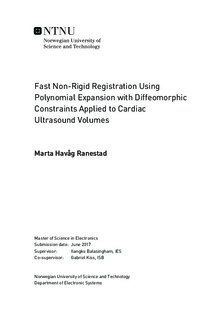Fast Non-Rigid Registration Using Polynomial Expansion with Diffeomorphic Constraints Applied to Cardiac Ultrasound Volumes
Master thesis
Permanent lenke
http://hdl.handle.net/11250/2454131Utgivelsesdato
2017Metadata
Vis full innførselSamlinger
Sammendrag
This thesis attempted to develop a fast, non-rigid, diffeomorphic image registration implementation and was written as a continuation of a project that was completed during the fall of 2016 \cite{prosjekt_oppgave} which developed and implemented a rigid image registration code. Non-rigid diffeomorphic image registration is already used in many diagnostic and research related medical situations, however due to the computational demands it is only used as a post-processing tool. This thesis focused mostly on how it could be used with 3D echocardiography to estimate a vector field representation of the movement of the heart, preferably in real-time.
To find these vector fields, Farnebäck's optical flow algorithm was used to decompose the images and represent them as polynomials that could be used to compute the local deformation for each voxel. Both a linear and a quadratic polynomial were used simultaneously, but it was found that using only the quadratic polynomial provided better results.
An iterative scheme was proposed to allow one deformation estimate to be used as a priori information for the estimate in the following iteration, and three different accumulation methods were implemented to make this iteration possible; additive, composite and exponential composite. The additive method simply added together the new estimate to the previously accumulated estimate while the composite method combined the new estimate and the accumulated estimate through linear interpolation. The exponential composite method found a recursive accumulation method by solving a linear differential with flow constraints. While it was found that the exponential composite provided more accurate and diffeomorphic results, it was almost twice as computationally expensive as the other two methods due to its recursive implementation.
The image decomposition and the image registration required a large number of matrix multiplications and inversions which made the algorithm a prime candidate for parallel programming, so the implementation was completed entirely on the GPU using OpenCL.
Theoretical diffeomorphic vector fields were created to test the code for accuracy and computational expense and an optimal set-up was found that was tested on real cases as well. The real cases showed deformation fields that were mostly diffeomorphic which indicated that the code had calculated realistic deformation fields. A comparison between running the code on a laptop computer and a desktop computer showed very different timing and indicated that real-time applicability of the method developed in this thesis will be highly dependent on the hardware of the device it is run on. However, both the real and theoretical cases indicated a high level of accuracy even with large deformations, so it is therefore reasonable to assume that in high frame rate cases, some frames in the 3D echocardiographic image sets can be skipped to achieve accurate, real-time results.
